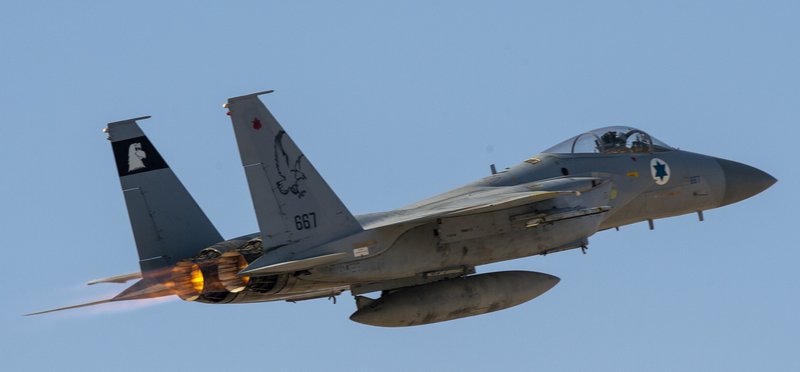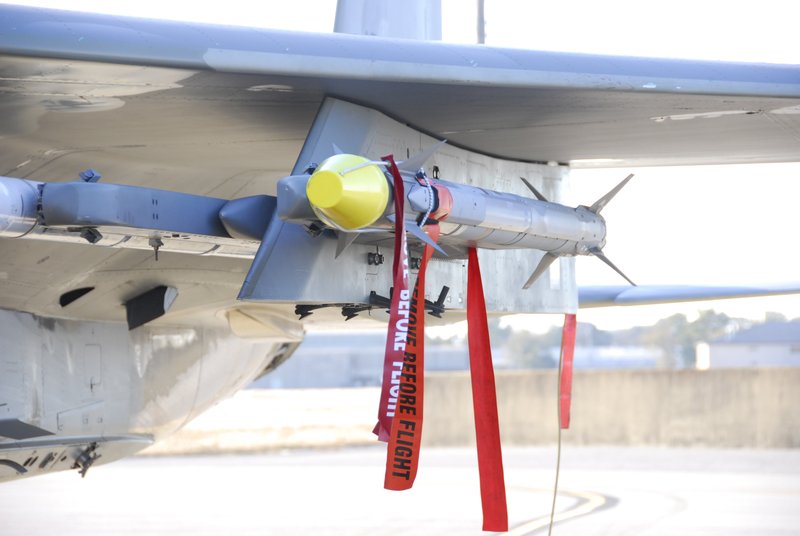Success, but at a cost – defending Israel from Iranian drones
On 14 April, using a combination of drones and missiles, Iran launched its first non-proxy attack on Israel. While this marks another worrying step at a political and conflict escalation level, the event raises points from a strategic and military perspective concerning integrated air defence, especially deployment of combat aircraft to neutralise incoming UAS and cruise missiles.
By most accounts, the Iranian attack used around 120 ballistic missiles, 30 subsonic cruise missiles and up to 170 of the now ubiquitous Shahed series of drones... Continues below
Newsletter Sponsor:

Above: Israel and its allies made widespread use of aircraft such as the F-15 to down incoming Iranian drones and cruise missiles using AAMs. (Photo: USAF)
From a purely kinetic perspective (damage inflicted), it was a complete failure – reportedly a large minority of these weapons suffered launch problems – while only around 1% of the remainder landed inside Israel.
As a demonstration of major air attack capabilities against another nation it was at best embarrassing and raises significant questions about the ‘bomber will always get through’ concern that had arisen from recent Russian attacks on Ukraine. Iran’s reputation for military capability, already not terribly high, has certainly suffered.
The Israeli defence effort was more complex and coordinated than anything Kyiv could have managed. As with previous successful operations of this type, it was founded on rapid and real-time tracking information about the inbound weapons.
This data was transmitted from different countries including Saudi Arabia, Qatar and the UAE as well as Jordan, over which Iranian missiles were flying. Information was coordinated at the US-led Combined Air Operations Center (CAOC) at Al Udeid in Qatar and then forwarded to air, land and sea forces of regional allies, including Israel.

It is also possible that some Arab countries, particularly Jordan, directly shared their information with Tel Aviv in this case, which would be a notable occurrence.
At a tactical level, the combined operation saw a major effort to intercept cruise missiles and drones using local fighter forces. This had previously occurred on an ad-hoc basis with Ukraine’s efforts to neutralise Russian equivalents and the use of Saudi F-15s against inbound Houthi assets.
More recently, USN F/A-18s had also engaged Houthi drones, with ‘kill’ markings seen on the aircraft alongside more frequent carriage of four AIM-9X short-range air-to-air missiles (AAMs).
But the scale of the Iranian attack and the significant early warning meant that fighters played a far greater role. This began with Jordanian F-16s, followed by US, UK and French jets contributing to the large number of downed Shaheds.
Indeed, it has been suggested that USAF F-15Es were responsible for a high percentage of the downed drones, something that will be a tonic to Boeing in its F-15EX pitch to Israel.
At the core, IDF pilots were used over their own cities as a backstop to traditional ground-based defences. This situation has not existed since the German V-1 offensives of 1944-45.
The airborne sensor capability, high mobility and ability of fighters to rapidly close with a threat suggests they form a strong defence against such an attack, and certainly under specific circumstances – such as massed assault on a vulnerable base or naval vessel – this approach does make sense.
Interestingly, Israel armed its F-15s with the older AIM-7 Sparrow AAM. With a larger warhead, against targets that are barely manoeuvring, this is sensible. But there is another reason to choose these missiles that speaks to an underlying problem with the use of fighters as defensive assets: the relative cost.
A Shahed drone is valued at around $50,000, allowing their use in the hundreds, while Iran’s cruise missiles come in at $200,000-300,000 apiece. Even at a 1:1 exchange rate, a $400,000 AIM-9X is clearly ‘inefficient’ in this regard.
An AIM-7 (with inflation) would likely be the equivalent of $1 million, although these are no longer in production, so the calculation is of less relevance. However, its modern equivalent, the AIM-120, costs roughly the same.
Cannon shells are low-cost, but unguided and short-ranged and so negate many of the aircraft’s advantages. The F-35 and others’ limited ammunition supply also does not help with this approach.

Above: While clearly effective against relatively slow and non-manoeuvrable targets such as a Shahed-series drone, an AIM-9X costs around eight times as much. (Photo: USN)
Added to the weapons element is the high operating cost of the aircraft and the limited ordnance that can be carried, requiring numerous returns to base for rearming over the course of a prolonged attack. The sustained effect on delicate fighter airframes and systems – impact on useful life – is another factor.
From a cold financial perspective, fighter aircraft are arguably wasted intercepting such basic threats. The importance of defending a nation, its civilians and military facilities is not questioned of course, only whether it can be sustained in this manner.
This is not simply an issue for fighter squadrons. Ground-based air defence missiles are not inexpensive with even the relatively low-cost Israeli Iron Dome interceptors quoted at around $50,000 each. Obviously, there are wider system sustainment and crewing costs, but a ground battery can field far more interceptors before resupply is needed and does not impose the support and maintenance burden of an F-15 Ra’am.
The same general argument can be made of a generic medium-range air defence battery using the AIM-9X or similar, which also avoids the fighter aircraft sustainment cost. Though an M104 Patriot or similar, at $4 million per missile, suffers a worse cost disparity, it can engage ballistic threats that fighters largely cannot. And again, its use-per-hour is fractional compared to a modern fighter.
This concern over wastage of high-tech weapons versus low is driving the rapid development of electronic means to engage Shaheds and similar. The idea of economy of defence against small- and large-scale attacks has been brought starkly into focus by the Iranian action.
Initial efforts in this area have focussed on electronic defences for ground units, followed by larger ship-based systems. Their extrapolation to use against strategic weapons will likely remain limited in the medium term, but the new systems should take the weight of a low-cost, swarming attack without wasting precious missiles.
What is less clear is how such technology might equip fighters. Basic energy ‘weapons’ exist in the shape of the directed IR countermeasure systems (DIRCMs) seen on helicopters and transport aircraft. These seek to blind incoming missiles but at present have no capacity to damage anything. Their development into rotary and possibly fixed-wing offensive effectors (eg on US AC-130s) is under way.
Their use on combat aircraft against incoming drones would not overcome the inherently high price tag of fighter operations, but would allow the latter’s speed and flexibility to be utilised without regard to missile cost. While lasers and similar would be likely shorter-ranged than even the most basic AAMs, these new effectors offer multiple engagement possibilities against several targets that are not possible with the small cannon magazine capacity of most fighters.
Power generation will be a problem, but fighters operating in such a role would likely not require their full suite of defensive aides and could probably retain or divert supply for an energy weapon.
Further Iranian and other attacks of this type will certainly see fighters used in the same defensive role. The short-term cost of airframe hours and missile stock depletion will be accepted given the threat level, but force commanders will be somewhat concerned about the wider impact on their usable fleet.
A likely outcome is that, barring a sudden new element entering this scenario, further effort and funding will be directed towards realising more efficient fighter interception of low-cost aerial weapons without expending a six-figure sum every time a drone is downed. As with the conflict in Ukraine, sudden necessity will likely reprioritise defence budget direction.
Other articles in this newsletter:
Don't want to miss out on future Decisive Edge content? Make sure you are signed up to our email newsletters.











